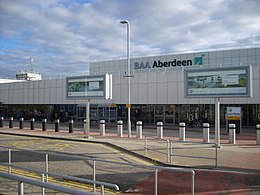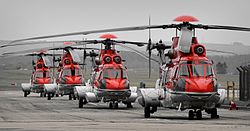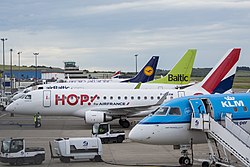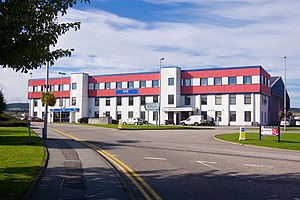Aberdeen Airport
| Aberdeen International Airport | |
| Code | IATA: ABZ, ICAO: EGPD |
|---|---|
| County | Aberdeenshire |
| Public | |
| Owner | AGS Airports |
| Operator | Aberdeen International Airport Limited |
| Location | Dyce, Aberdeen 57°12’9"N, 2°11’53"W |
| Website | |
Aberdeen International Airport is an international airport, located in Dyce, a suburb of Aberdeen, approximately five nautical miles north-west of Aberdeen city centre. A total of just under 3.1 million passengers used the airport in 2017, an increase of 4.6% compared with 2016.
The airport is owned and operated by AGS Airports which also owns and operates Glasgow and Southampton airports. It was previously owned and operated by Heathrow Airport Holdings (formerly known as BAA). Aberdeen Airport is a base for Eastern Airways, Flybe and Loganair. The airport also serves as the main heliport for the offshore oil industry. With the utilisation of newer aircraft, helicopters can reach northernmost platforms on both the east and west of Shetland areas. However, helicopters also sometimes use Wick, Kirkwall, Scatsta and Sumburgh for refuelling stops.
The airport has one main passenger terminal, serving all scheduled and charter holiday flights. In addition, there are four terminals dedicated to North Sea helicopter operations, used by Bristow Helicopters, CHC Helicopter, NHV and Babcock Mission Critical Services Offshore. Bristow Helicopters also have a small terminal adjacent to the main passenger terminal, used primarily for oil company charter flights to Scatsta and Sumburgh in Shetland, operated by Eastern Airways.
Contents
History
Early years
The airport opened in 1934, established by Eric Gandar Dower, intended to link the northern islands of Scotland with London.
During Second World War the airfield became a Royal Air Force station – RAF Dyce. It was the site of the Dyce Sector Operations Room within No. 13 Group RAF. Although fighters were there throughout the Battle of Britain to provide protection from German bombing raids from Occupied Norway, it was mainly used as a photographic reconnaissance station. Anti-shipping operations by Coastal Command were carried out from RAF Dyce as well as convoy escort. The airfield was bombed by the Luftwaffe on 26 July 1940 and 27 August 1940, no damage was reported. A decoy site ('Q' Site) was located at Harestone Moss near Whitecairns. The aim of this site was to create the impression of an active airfield during the night. The decoy worked on around four occasions, where several raids resulted in bombs being dropped on the decoy site. The decoy site had a small underground bunker that housed a generator. This was used to power a decoy 'flarepath' in addition to a rotating lamp to give the impression of a taxiing aircraft. Near the airport off the A96, to deter German gliders landing to attack RAF Dyce during WW2, the flat areas across from Concraig Farm (between Blackurn and Kintore) had wooden poles erected as anti-glider landing poles. A Spitfire IIa crashed at the east side of the airfield on 19 November 1941 during attack practice with a target glider being towed. F/O Zaoral is buried in the old Dyce graveyard, where some German aircrew are also buried that crashed in Aberdeen in 1940.
A significant wartime event occurred in May 1943 when a German, Junkers Ju 88 night fighter landed here; it was flown to Britain by its crew, who wanted to defect to the Allied side.[1] The surrender of this aircraft was of great intelligence value at the time, as it was fitted with the latest FuG 202 Liechtenstein BC A.I radar. The aircraft survives and is displayed in the RAF Museum in London.[1]
On 17 August 1943, a Mosquito crashed following a stall in the circuit, crashing onto 5 John Street in Dyce village; another Mosquito on 10 April 1944 crashed on approach to the airfield. On 26 December 1944, A Messerschmitt BF109G signalling intentions to surrender crash landed at the airfield. On 16 May 1945, two pilots were killed when a Wellington bomber crashed on landing wrecking a goods train in Dyce Station. During air raids in the Second World War, aircraft were moved to East Fingask beside Oldmeldrum. One RAF building still remains at East Fingask, where aircrews waited for the "All Clear" before returning to Dyce airfield.
The following units have been based at Aberdeen Airport:[2]
- No. 9 Blind Approach Training Flight RAF
- No. 662 Gliding School RAF
- No. 663 Gliding School RAF
- No. 1509 (Beam Approach Training) Flight RAF
- No. 2737 Squadron RAF Regiment
- No. 2784 Squadron RAF Regiment
- Aberdeen University Air Squadron
Virtually nothing remains from the war era at the airport due to expansion and development of the industrial estates around it. The original airport terminal was located at the East Side where the Bond Offshore Helicopters Terminal 2 is located, a new terminal was built along with a new control tower to handle the increase in air traffic. The airport was nationalised in 1947 and was transferred to the control of the British Airports Authority (BAA) in 1975.[3] From 1967 and 1970 there were regular flights to Moscow and Toronto; these were later stopped due to cost related problems.
With the discovery of North Sea oil, helicopter operations began in 1967, linking the growing number of oil platforms to the mainland. As Aberdeen became the largest oil-related centre in Europe, the airport became the world's largest commercial heliport. As of 2017, Aberdeen Airport handles more than 37,000 rotary wing movements carrying around 468,000 passengers annually. Helicopters account for almost half of all aircraft movements at the airport.
Development since the 2000s
Until March 2005, aircraft were not allowed to take-off or land between 22:30 and 06:00 local time due to noise constraints. The city council overturned this ban, however, despite some Dyce residents' objections, and the airport is now open 24 hours a day to fixed-wing aircraft[4] with a quota count of QC4 or below, and the overnight restrictions still apply to helicopters.
General aviation flight training for private pilots licences takes place from the East Side of the airport. Signature Flight Support also handles most of the private flights and corporate jets that park on the Eastside Apron. The air ambulance (fixed wing) is positioned on the eastside apron in a dedicated hangar, Gama Aviation operates King-Air aircraft from Aberdeen.
Aberdeen, being a major city in the oil industry has a number of oil company charter flights, these have included flights to South America and also Korea (via Abu Dhabi). Flights from the USA are regular visitors and the occasional military flights have also landed.
On 6 October 2011, a 124-metre extension to the main runway at the airport was opened, almost eight months ahead of schedule.[5] On 8 January 2013, the airport was renamed Aberdeen International.[6]
In October 2014, Heathrow Airport Holdings reached an agreement to sell the airport, together with Southampton and Glasgow, to a consortium of Ferrovial and Macquarie Group for £1 billion.[7] The airport handles around 500,000 passengers per year by helicopter for the North Sea oil fields.[8] making it the world's busiest heliport.[9]
A total of just under 3.1 million passengers used the airport in 2017, an increase of 4.6% compared with 2016.[10] The airport's Master Plan 2013 forecast growth to 5.09 million passengers a year by 2040.[11] A major three year project (2016-2019) aims to transform the passenger terminal and increase space by 50%[12].
Facilities
There are Jurys Inn, Premier Inn, Courtyard by Marriott, Holiday Inn Express and Crowne Plaza hotels on the airport site, as well as a Speedbird Inn. On 10 January 2013 it was also announced that Accor Group will be bringing two new hotels to the airport, a 194-bedroom Novotel hotel and the other a 112-bedroom Ibis hotel. At least one more hotel[13] is planned for the adjacent Aberdeen International Business Park starting in 2016.
BMI Regional had its head office in Aberdeen Airport East.[14]
For flight training, Airbus/Eurocopter and Bristow Helicopters both have helicopter flight simulators in buildings at the airport. Alexander Air also operate GA flight training based from Aberdeen Airport.
Transport
Rail
The airport is no longer linked to the Dyce railway station by the 80 Dyce Airlink shuttle bus.[15] Instead, travellers can walk 3 miles from Dyce station, or use the 727 bus from Aberdeen station.
Bus
Aberdeen Airport is served by local and express bus services operated by First Aberdeen and Stagecoach Bluebird. There is a dedicated No.727 bus service up to every 10 minutes to the main bus and rail station in central Aberdeen. The 747 bus (operated by Stagecoach Bluebird) provides connections to Montrose and Stonehaven, the 757 to Newtonhill and Portlethen and both to Ellon, Cruden Bay and Peterhead
Chartered buses can also be booked with local operators.
Road
The airport lies on the main A96 Aberdeen to Inverness road, being only a few miles from the city centre itself.
References
- ↑ 1.0 1.1 (PDF) Individual history: Junkers Ju88 R-1 W/Nr.360043/PJ876/8475M Museum Accession Number 78/AF/953, RAF Museum, archived from the original on 13 May 2012, https://web.archive.org/web/20120513222146/http://www.rafmuseum.org.uk/london/collections/aircraft/aircraft_histories/78-AF-953%20Junkers%20Ju88%20R1.pdf, retrieved 14 February 2010
- ↑ "Dyce (Aberdeen)". Airfields of Britain Conservation Trust. http://www.abct.org.uk/airfields/airfield-finder/dyce-aberdeen/. Retrieved 10 February 2016.
- ↑ "Who we are". Heathrow Airport Holdings. 2013. http://www.baa.com/about-baa/who-we-are. Retrieved 28 January 2013.
- ↑ "Airport given overnight approval". BBC News. 2 March 2005. http://news.bbc.co.uk/2/hi/uk_news/scotland/4312677.stm. Retrieved 28 March 2012.
- ↑ "Aberdeen Airport runway extension opening". Aberdeen Airport. 6 October 2011. Archived from the original on 17 November 2011. https://web.archive.org/web/20111117022916/http://www.aberdeenairport.com/about-us/media-centre/press-releases/aberdeen-airport-runway-extension-opening. Retrieved 28 March 2011.
- ↑ "Airport rebranded 'Aberdeen International'". BBC News. 8 January 2012. https://www.bbc.co.uk/news/uk-scotland-north-east-orkney-shetland-20937413.
- ↑ "Aberdeen, Glasgow and Southampton airports sold in £1bn deal". BBC News. 16 October 2014. https://www.bbc.co.uk/news/uk-scotland-29650438. Retrieved 20 October 2014.
- ↑ Swartz, Kenneth I. (16 April 2015). "Setting the Standard". Vertical Magazine. http://www.verticalmag.com/news/article/31306. Retrieved 18 April 2015.
- ↑ "Air traffic timelapse: untangling Britain's plane-filled skies" The Telegraph 1 July 2015
- ↑ "Aircraft and passenger traffic data from UK airports". UK Civil Aviation Authority. 3 March 2017. http://www.caa.co.uk/Data-and-analysis/UK-aviation-market/Airports/Datasets/UK-airport-data/. Retrieved 15 March 2017.
- ↑ "Aberdeen Airport Master Plan 2013". https://www.aberdeenairport.com/media/42246/AIAL-Final-Master-Plan-2013.pdf. Retrieved 17 April 2018.
- ↑ "Passenger Terminal Transformation". https://www.aberdeenairport.com/about-us/terminal-transformation/. Retrieved 17 April 2018.
- ↑ "Oil firm signs major office lease". 12 August 2014. https://www.bbc.com/news/uk-scotland-scotland-business-28755287.
- ↑ "General Conditions of Carriage." British Midland. Retrieved 28 December 2011. "British Midland Regional Ltd Registered Office Aberdeen Airport East Wellheads Drive Dyce Aberdeen AB21 7EU"
- ↑ "Bumpy Ride for Passengers". https://www.pressreader.com/uk/the-press-and-journal-aberdeen/20170515/281608125359291.
Outside links
| ("Wikimedia Commons" has material about Aberdeen Airport) |



